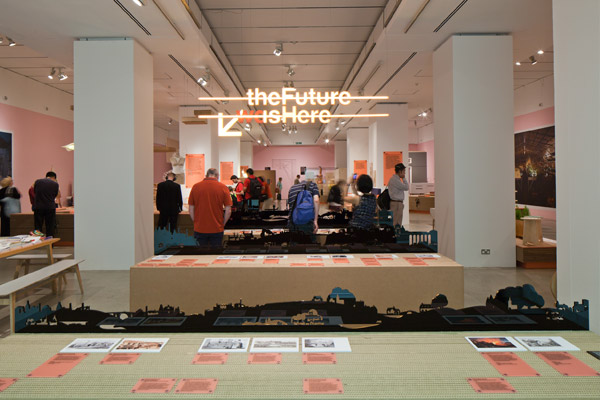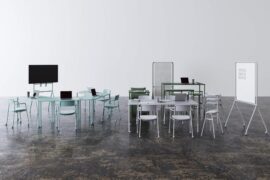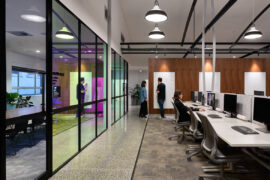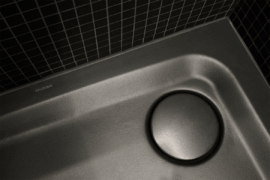Elana Castle chats to RMIT Design Hub curator Kate Rhodes about The Future is Here, a touring exhibition created by the Design Museum in London and destined for the RMIT Design Hub in August.

July 17th, 2014
Images show The Future is Here exhibited at the London Design Museum.
What is the premise behind The Future Is Here?
The Future is Here is an exhibition about a new industrial revolution. We are experiencing significant changes in the way we design, make and consume the objects that we depend on. New digital manufacturing methods, coupled with an online marketplaces, open source design and social networking are, in many cases, making the factories of the past redundant. Until now small scale makers have produced only those objects that factories don’t. But what would happen if small companies, or even individuals, began making objects that were previously only viable through mass production? The Future is Here asks what that means for all of us.
How will this exhibition express these transformational and emerging trends?
The Future is Here is a terrific survey of objects and ideas on the changing nature of how design enters the world today. New techniques and new relationships – including new technologies and platforms such as crowd funding and social networking – mean that the boundaries between designer, manufacturer and user are becoming increasingly blurred. Greater access to information about how objects are made, as well as access to those who traditionally make them, is revolutionising the role of the consumer so that more people than ever before are taking part in the production of our physical world. The Future is Here plots the recent history of design fabrication and puts these changes in context.
What is the underlying concepts of the exhibition design itself?
The exhibition design is an important research project that forms ‘the structure of the exhibition’. Designed by Studio Roland Snooks, the design brings together advanced manufacturing techniques such as robotic manufacturing along with traditional boat building – a real example of collaborative and innovative design.
Please tell us more about the “Bloom” project which will be exhibited in conjunction with The Future is Here.
Bloom is large-scale interactive installation designed and developed by Alisa Andrasek and Jose Sanchez. The urban toy, distributed social game and collective ‘gardening’ experience was first installed in London during the 2012 Olympics and Paralympics. The project provides an important opportunity for collaborative exchange where RMIT Design researchers and students will have the opportunity to work directly with Alisa and pursue ideas that experiment with advanced design processes, bio-architecture and social networking platforms.
The Computation of Bloom from Jose Sanchez on Vimeo.
The Future is Here
28 August to 11 October
Design Hub, Building 100, RMIT University
designhub.rmit.edu.au/exhibitions-programs/the-future-is-here-
Bloom Game
bloom-thegame.com
The exhibition will be accompanied by a full program of associated lectures, talks and workshops.
INDESIGN is on instagram
Follow @indesignlive
A searchable and comprehensive guide for specifying leading products and their suppliers
Keep up to date with the latest and greatest from our industry BFF's!
The new range features slabs with warm, earthy palettes that lend a sense of organic luxury to every space.

Welcomed to the Australian design scene in 2024, Kokuyo is set to redefine collaboration, bringing its unique blend of colour and function to individuals and corporations, designed to be used Any Way!

A longstanding partnership turns a historic city into a hub for emerging talent

For Aidan Mawhinney, the secret ingredient to Living Edge’s success “comes down to people, product and place.” As the brand celebrates a significant 25-year milestone, it’s that commitment to authentic, sustainable design – and the people behind it all – that continues to anchor its legacy.

Could thinking like a kid be valuable in the workplace? Ku.Be by MVRDV and ADEPT is a new typology for a community building designed to encourage play and bring out the inner child in users.
The Good Sheds North project in Melbourne’s docklands has dominated this year’s BPN Sustainability Awards.
The internet never sleeps! Here's the stuff you might have missed

A retrospective at Canberra Museum + Gallery honours Enrico Taglietti, shaping the exhibition through his own design principles.

Architectus’ new headquarters for Q-CTRL addresses complex technical requirements while creating an enjoyable place to work.

Overlooking Berlin Zoo, the suites of the 25hours Hotel Bikini Berlin curate the sustainability ethos in an entirely unique and dynamic aesthetic. Think natural fabrics and materials, jewel-hued colours, curves and cushions, spa-like bathrooms and hammocks with views over urban greenery.